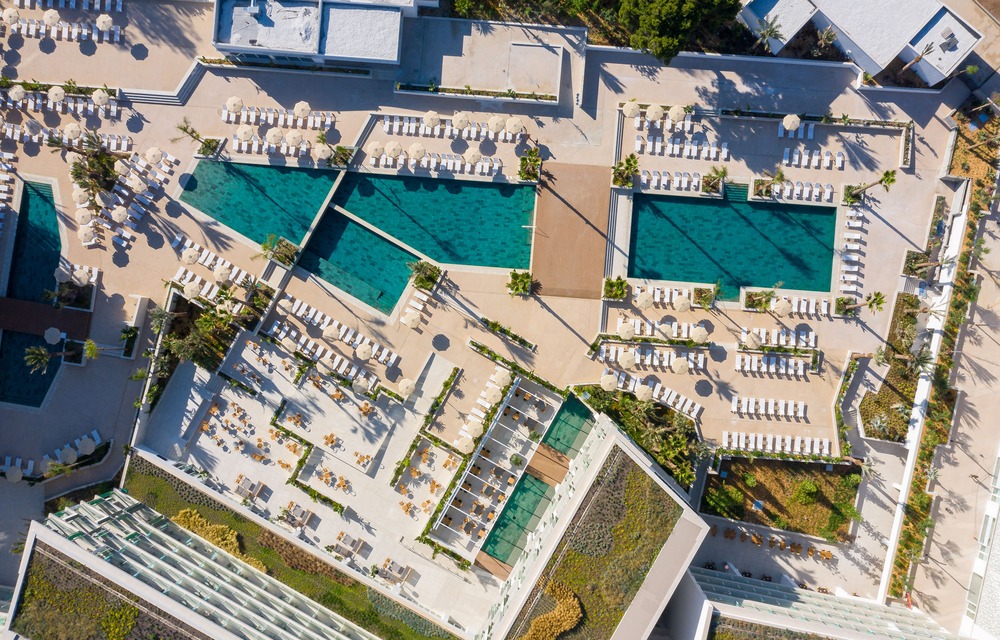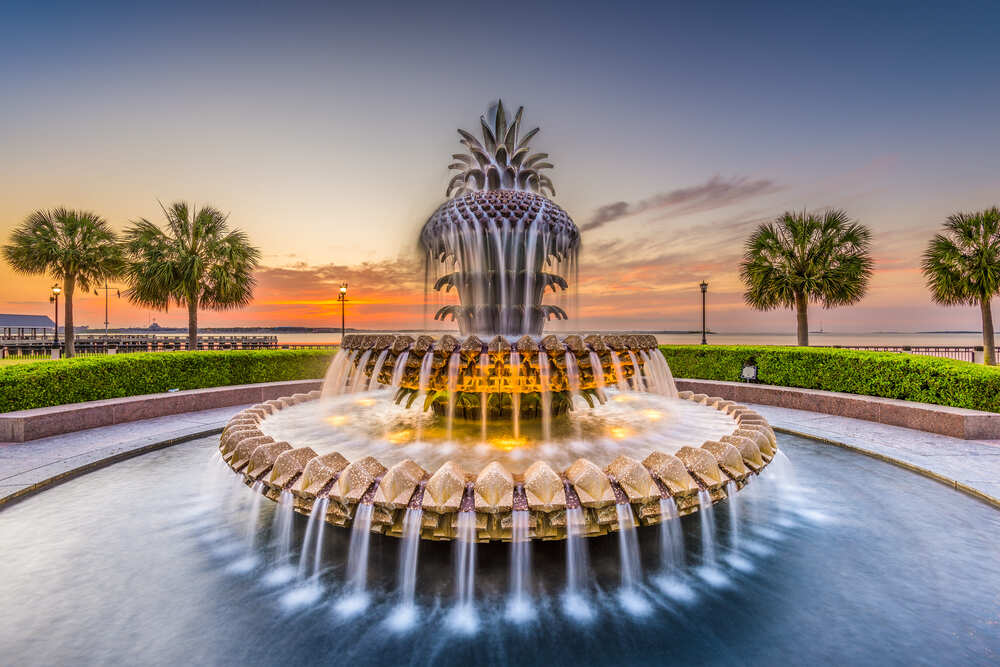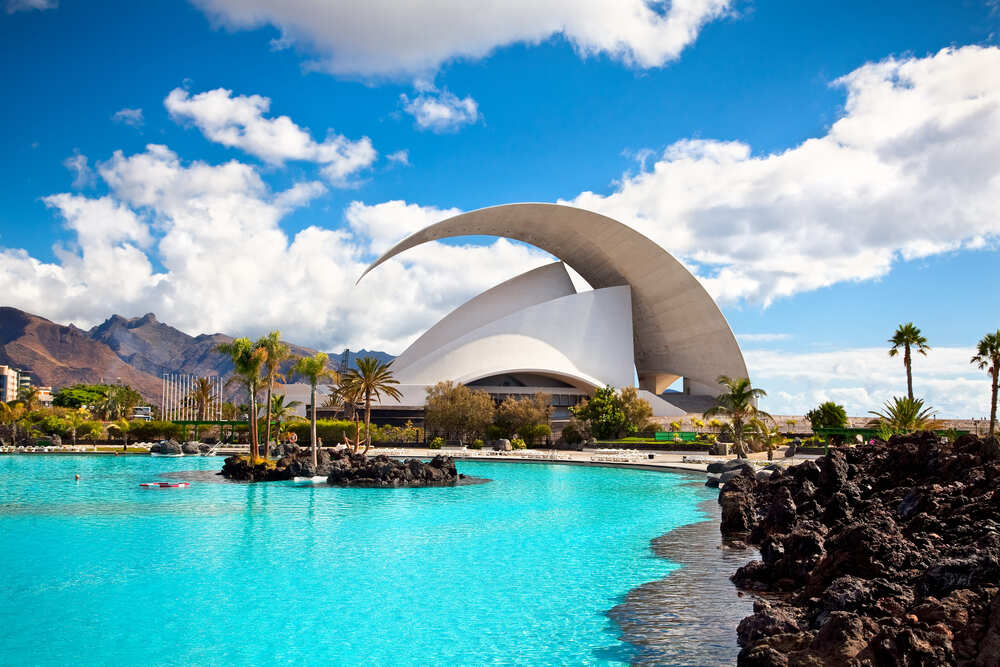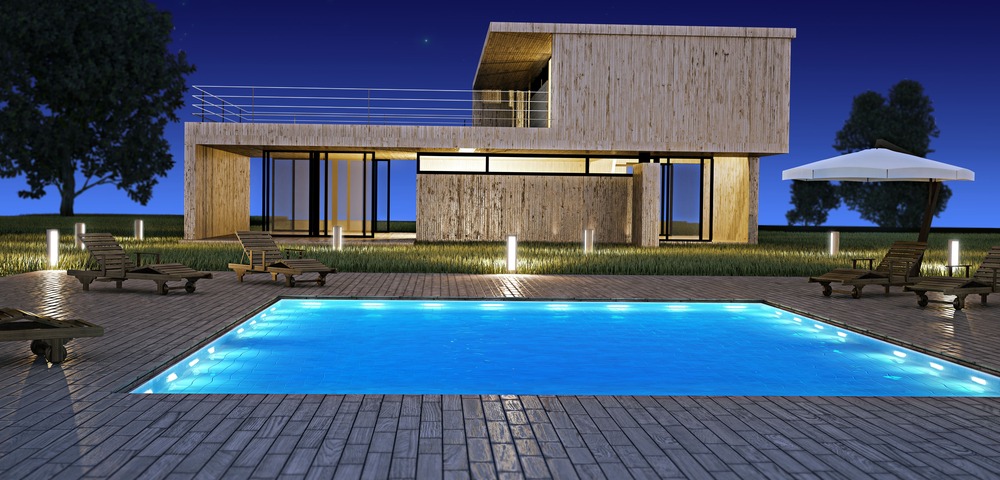Water in architecture has been a central element of architectural and urban design for millennia, transforming spaces by combining aesthetic appeal, functionality, and symbolic significance.
In the ancient Hanging Gardens of Babylon, water in architecture meant cascading water features cooling the arid landscape. In the aqueducts of the Roman Empire, water was channeled for both practical and ornamental purposes. The intricate water gardens of the Alhambra in Spain, and the serene reflecting pools of the Mughal gardens in India are two other examples of how water in architecture has left an enduring legacy on built environments around the world.
Today, water in architecture has become a central piece of certain contemporary design projects, with examples such as the Jewel Changi Airport or the Gardens by the Bay, both in Singapore. Two examples that illustrate modern architecture’s capacities to seamlessly weave water into the fabric of spaces, creating experiences that are functional, sustainable, and aesthetic.
In this article, we explore the significance of water in architecture and how aquatic elements can contribute to a space’s aesthetic appeal, recreational value, and sustainability, as well as the capacity of water in architecture to foster community and promote economic development.
Dive deeper with the eBook

What role does water play in architecture?
The modern approach to integrating water in architecture goes beyond ornamentation, seeking to create spaces that inspire, engage, and promote well-being.
Whether it’s the tranquil ambiance of a reflective pool, a thrilling waterslide, or the rejuvenating properties of a thermal bath,water features enrich our lives in countless ways:
- From a functional perspective, water features can cool, reduce noise, and even serve as a renewable energy source.
- From a social standpoint, they create gathering places, thus fostering community interaction. Additionally, the presence of water features has been linked with improvements in the psychological well-being, providing a sense of tranquility and connection to nature that further enhances the overall livability of urban areas.
- From an economical point of view, water in architecture can contribute to economic development by attracting tourism and boosting property values.
- From an environmental perspective, they can contribute to water conservation efforts, habitat creation, and the mitigation of urban heat islands.
In this context, the strategic incorporation of water in architecture requires a holistic design approach that addresses water’s visual appeal as well as its functional utility and the project’s overall environmental sustainability.

What are the options to incorporate water in architecture?
Swimming pools: architectural centerpieces and recreational havens
Swimming pools remain a staple in residential, resort, and community designs. These oases offer a respite from the daily grind, providing opportunities for exercise, relaxation, and socializing.
Swimming pools in contemporary architecture projects typically present the following characteristics:
- Integrated seamlessly into the surrounding landscape, creating a harmonious blend of nature and human-made structures.
- Prioritization of energy efficiency, utilizing advanced filtration systems and sustainable materials to minimize the pool’s environmental impact and operational costs.

Fountains: combining art, engineering, and environmental stewardship
Fountains have transcended their utilitarian origins, evolving into sophisticated installations that blend artistic expression with engineering ingenuity. Interactive water displays, synchronized with light and sound, have become focal points for public spaces, enhancing the overall ambiance.
Beyond their aesthetic appeal, fountains play a crucial role in environmental health. They aerate water, improving its quality, and help mitigate the urban heat island effect by cooling the surrounding air. Additionally, the soothing sound of flowing water can mask the harsh noises of urban environments, creating more tranquil and inviting spaces.
Fountains have evolved from simple stone structures to complex engineering projects such as floating fountains. As such, modern fountains today often incorporate:
- Intricate plumbing systems and powerful pumps
- Advanced lighting technologies like LED or fiber optics to create mesmerizing displays.
- Interactive water displays can be incorporated that respond to user input and create dynamic and engaging experiences.
- Durable materials like stainless steel, bronze, or even glass to ensure longevity and resilience in diverse weather conditions.

The oasis-like experience of artificial lagoons
Artificial lagoons have emerged as a popular way to bring the beauty of the beach to landlocked areas. These expansive bodies of water offer various recreational activities, from swimming and kayaking to paddleboarding and sunbathing. As such, they represent an attractive addition that boosts value for resorts, residential communities, and urban centers, providing a welcome escape from the stress of urban life.
In order to achieve their maximum potential, artificial lagoons incorporate:
- State-of-the-art filtration systems to ensure that the water remains pristine, and which may include natural pool design possibilities.
- Advanced temperature control systems to guarantee water is enjoyable throughout the year, regardless of climate conditions.

Embracing the therapeutic power of water in wellness spaces
The incorporation of water features in modern wellness centers puts the therapeutic properties of water at the center. Some examples include how mineral springs, thermal baths, and hydromassage beds offer a range of health benefits, including improved circulation, reduced stress, and pain relief.
In order to achieve these benefits, some tips for wellness spaces to incorporate water in architecture include:
- Must understand aesthetics and ambiance play a significant role in creating a relaxing and appealing experience for users. As such, the design of these facilities should consider factors like acoustics, lighting, and the use of natural materials to create a serene and calming environment.
- Hydrotherapy pools will need to consider how strategically placed jets and varying water temperatures can target specific muscle groups and promote relaxation.
- Thermal baths, on the other hand, need to incorporate the natural heat of geothermal sources to offer a soothing and therapeutic experience.
How to ensure sustainability when incorporating water in architecture?
Sustainable design principles can be applied to water features in various ways. Water recycling systems, rainwater harvesting, and the use of solar-powered heating and filtration systems are just a few examples of how architects and engineers can minimize the environmental impact of aquatic facilities.
On the other hand, the incorporation of technologies can also be an ally for sustainability:
- Smart water management systems, powered by sensors and artificial intelligence, optimize water usage and ensure efficient operation.
- Collaborative design tools like BIM streamline project workflows and can incorporate analysis around energy and resource modeling to ensure optimization.
- CFD simulations and VR visualizations serve as an invaluable aid in the design and optimization of complex water features, and can also incorporate notions around achieving the project’s maximum sustainability.

Why is water in architecture growing as a trend?
Whether it’s a tranquil reflecting pool that invites contemplation, a vibrant fountain that celebrates the community spirit, or a state-of-the-art swimming pool that promotes health and well-being, water in architecture cantransform ordinary spacesinto extraordinary destinations.
By embracing water’s multifaceted potential, it’s possible to create environments that not only meet users’ functional needs but alsoinspire, delight, and connectthem to the natural world.
As the move towards a more sustainable and equitable future, the thoughtful incorporation of water in architecture will undoubtedly play a vital role in shaping the architecture spaces of tomorrow.
In this quest, Fluidra stands out as an invaluable ally. As global leaders in aquatic design and engineering, we provide the expertise to guide water in architecture projects to achieve their maximum potential.
Frequently asked questions about water in architecture
What is the concept of water in architecture?
Water in architecture involves the intentional integration of water as a design element within built environments. Within this framework, water is employed in architecture projects as an element that transforms the function of spaces, but also the experience and meaning of the project, building from water’s deep cultural and symbolic background.
What is a water feature in architecture?
Water features in architecture are man-made elements where water has been deliberately incorporated to enhance the experience of a space. Water features in architecture can take many shapes: from swimming pools that reflect buildings, to water walls, indoor and outdoor fountains that serve as a meeting place or complex interactive water installations, to name a few.
Why is water important in architecture?
When integrated into architecture projects, water brings unique benefits in a wide range of areas:
- Functionally, it serves to cool spaces, reduce noise, and as a potential source of renewable energy.
- Socially, it encourages gathering and enhances psychological well-being through transmitting tranquility and connection to nature.
- From an economical perspective, water features can attract tourism and increase property values.
Environmentally, it supports water conservation, habitat creation, and reduces urban heat.
